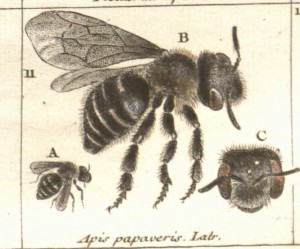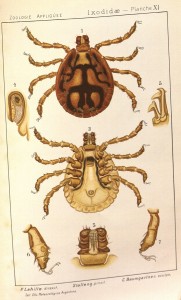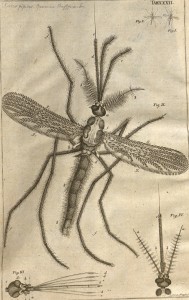By Sarah Juntunen
Student Staff at the Wangensteen Historical Library of Biology and Medicine
 The summer months are upon us, and that can only mean one thing—bugs. At the Wangensteen Historical Library, we have an abundance of material on the topic of insects with accompanying medical advice and historical perspectives
The summer months are upon us, and that can only mean one thing—bugs. At the Wangensteen Historical Library, we have an abundance of material on the topic of insects with accompanying medical advice and historical perspectives
Riley and Johannsen (1915) wrote in their book, “Handbook of Medical Entomology,” that “[Insects and their allies] may be the enemy of mankind” and I believe all can attest to this statement. Insects have been studied for centuries and several preventative measures can be taken to avoid the harmful effects of these tiny foes.
Bee stings
Trying to avoid the reaction to a bee sting this year? Prepare yourselves using the advice given in the “Handbook of Medical Entomology.” Take a live bee and press it into the skin on the back of your hand until it just barely stings you. Repeat this every 4-5 days for 3-4 weeks until you get an all-over itching sensation.
Once these sensations occur, halt treatment and wait a month before resuming the process. Repeat at these intervals until the itching sensation lessens and eventually disappears (Riley and Johannsen, 1915). You will have acquired immunity and bees will be the least of your problems.
So enjoy the sun while it’s around (considering that we only get summer for 20 days here in Minnesota); It won’t be long before we will be headed back into hibernation and our fight against bugs will return to a fight against the polar vortex, or as I like to call it “winter.”
Ticks
 The only thing that is worse than the thought of snow at this point is an infamous tick discovery commonly associated with the summer months. My skin is crawling just thinking about it.
The only thing that is worse than the thought of snow at this point is an infamous tick discovery commonly associated with the summer months. My skin is crawling just thinking about it.
Riley and Johannsen have a bit of advice if you find yourself with one of these parasites. Ticks can be removed in various ways which include:
- Applying gasoline, petroleum, oil, Vaseline or cotton soaked in chloroform (the group B2 probable human carcinogen) to the site where the tick is attached.
If that doesn’t sound like respectable medical advice, I’m not sure what does.
Mosquitos
 Mosquitos are indeed the “notorious pests of man” as described by Riley and Johannsen (1915). They are blood thirsty and enormous in number and therefore, require community action.
Mosquitos are indeed the “notorious pests of man” as described by Riley and Johannsen (1915). They are blood thirsty and enormous in number and therefore, require community action.
Today’s traditional actions to rid ourselves of these pests include:
- Draining boats and fishing materials, and eliminating standing water
- Preventative measures taken from the “Handbook of Medical Entomology” propose the draining of ponds (while you may win the battle against mosquitos using this tactic, I have a feeling you may have to fight a bigger battle with the EPA)
- Draining of pools, and clearing temporary breeding places such as cans, pails, water buckets, and barrels.
However, these are just suggestions for future impact. If you are looking for immediate relief from these most despised insects, all you need to do is mix together mutton tallow, black tar, citronella, and pennyroyal–with this mixture you will repel mosquitos and, likely, people as well. Alternatives to this repellant include ointments of tar and cream or fish grease.
References
Coquebert de Montbret, A. J. & Fabricius, J. C. (1799). Illustratio iconographica insectorum quae in Musaeis parisinis observavit et in lucem edidit Joh. Christ. Fabricius, praemissis ejusdem descriptionibus; accedunt species plurimae, vel minus aut nondum cognitae. Parisiis.
Lahille, F. (1905). Contribution à l’étude des ixodidés de la République Argentine
Anales del Ministerio de agricultura. Sección de Zootecnia, bacteriologia, veterinaria y zoologia ; tomo 2, núm. 2. Buenos Aires: Imprimerie du Beaureau Meteorlogique.
Riley, W.A. & Johnssen, O.A. (1915) Handbook of Medical Entomology. Ithaca, NY: The Comstock Publishing Company.
Swammerdam, J. & Boerhaave, H. (1752). Bibel der Natur, worinnen die insekten in gewisse classen vertheilt, sorgfältig beschrieben, zergliedert, in saubern kupkerstichen vorgestellt, mit vielen anmerkungen über die seltenheiten der natur erleutert, und zum beweis der allmacht und weisheit des schöpfers angewendet werden. Leipzig: J.F. Gleditschens buchandlung.



